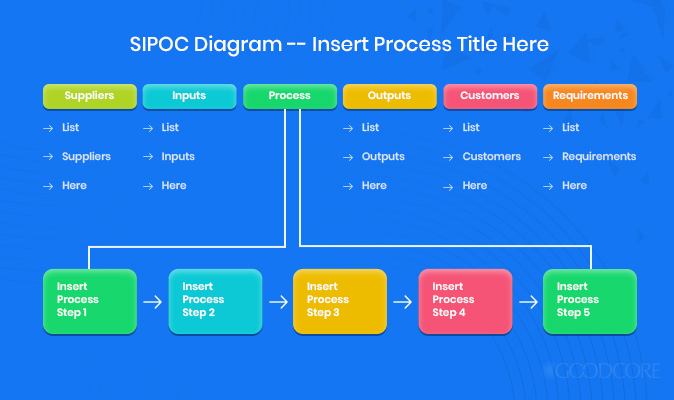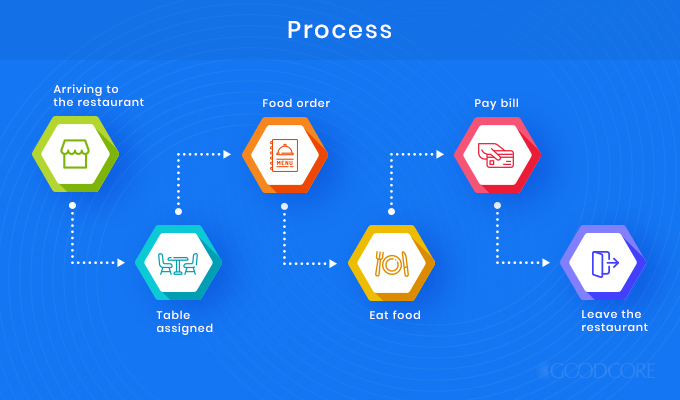Business processes typically involve multiple stakeholders such as suppliers and customers along with various inputs and outputs. Often tools and methodologies are used to summarise and visualise the information about business processes in the form of tables and diagrams. And one such tool that can be used to visually document a business process is a SIPOC Diagram. This tool can be used to provide quick, simple, and relevant information about the process. So what, exactly, is SIPOC and how can it be utilised?
Let’s find out!
What is SIPOC – Definition and Usage
In simple terms, SIPOC is a Lean Six Sigma tool that is used for mapping processes by constructing a SIPOC diagram. SIPOC stands for:
- Suppliers
- Inputs
- Process
- Outputs
- Customers

While mapping any process, a SIPOC diagram summarises the inputs, outputs, process steps and other key information in a table format.
But why is process mapping, like SIPOC, important? It is important because it helps with the analysis and problem-solving. It also aids in identifying inefficiencies and waste within the business process so it could be improved and made more efficient.
Continue reading this blog to learn more about how SIPOC diagrams are constructed, their uses and examples.
What is a SIPOC Diagram?
SIPOC Diagram basically helps understand how a business process works by visualising it. Typically, it is in a tabular form with separate columns for each element. Information regarding the roles, responsibilities, and standards are outlined in the diagram. The main aim of presenting the information in a tabular form is to structure the data to make it quick and easy to read. A glance at a SIPOC diagram can tell you the following:
- What is the number of steps involved in the process?
- Who is responsible for each step?
- What are the required inputs and outputs?
- Who are the suppliers and customers of the process?
Below is a template of a SIPOC diagram provided by Six Sigma. Each column includes information about each element. For example, in the column for Suppliers, you list down all the stakeholders who provide inputs for the process. For inputs, you list down all the resources that are supplied by those listed in the column for suppliers. In the column for Processes, you list all the steps involved in the process to convert inputs into outputs. For Outputs’ column, you list all the resulted products or services. Lastly, for the column of Customers, you mention all the stakeholders who are the recipients of the outputs.

Let’s talk about each element of the SIPOC diagram in a little bit more detail.
Step-1: Supplier
Suppliers are the key stakeholders in every process as they are those who provide inputs. A supplier of a process can be internal or external to your business.
One of the best SIPOC examples is that of a software development project where an enterprise wants to avail the mobile application development services of a software development company. Well, an obvious understanding of the scenario is that the software development company is the supplier and the enterprise is the customer, right?
But, according to the SIPOC diagram, suppliers include anyone that provides input during the process (i.e. the process of software development) and not only service providers. Therefore, the SIPOC diagram for this process would include the following suppliers:
- Customers: because they request for the software to be developed and also provide inputs in the form of requirements
- Project Manager(s): because they provide their management skills that are required in the process
- Software Engineers: because they provide their skills and knowledge for the process. These will include all technical personnel such as analysts, programmers, developers, SQA officers etc.
Step-2: Input
Inputs are the key requirements. They can be in the form of services, products, skills or information that are needed for the process to work. They represent what suppliers provide. So for our custom software development process example, the inputs would include:
- Customer Requirements: These can be in the form of User Requirement Specifications (URS) and Functional Specification Document (FSD) to outline the requirements and functions of the required software.
- Skills and Knowledge: The input of all the technical personnel involved at every step of the process.
- Databases, Hosting Services, and Frameworks: All the technical requirements of the process that needed to build the software.
- Project Management Tools: Tools that will be required to plan and monitor the project.
Step-3: Process
The process is the structured steps performed to convert inputs into outputs. The process can be divided into 5-7 easy steps. For simpler processes, the process name should follow a “verb + noun” format. For example, “Receive Orders”, “Assemble Items”, “Confirm Payment” etc. For our SIPOC example for software development, the process can be divided into the phases of Software Development Life Cycle (SDLC). The process can then simply be divided into steps involving:
- Requirement analysis
- Design
- Development/Coding
- Testing
- Release
- Maintenance
Step-4: Outputs
Outputs are the results obtained after performing the process steps. Every output must have a customer and must be based on their requirements. An obvious output of a process is the service or product that is being created.
However, any product or service that is produced at a step to be used in the later steps will also be considered an output. For example, a requirement document that is made at the step of requirement analysis is an output that is used throughout the rest of the steps of the software development process.
For our SIPOC example for software development, the outputs would include:
- Custom created software
- Documentation
- Design diagrams
- A completed project
- A satisfied client
Step-5: Customer
Customers are important stakeholders and for every process, there can be two types of internal or external. You can think of customers in two ways: they can either be your clients like the organisation for which you are developing the software and who are going to be the end-users. Customers can also be your employees performing the process using outputs produced at the previous step. Since essentially they both use the process outputs, they both can be called customers.
To follow the same SIPOC example for software development, the customers would include:
- Your Business
- Users
- Clients
- Third-party
- Technical Personnel
An Easy Real-Life SIPOC Diagram Example
SIPOC can be used to map complex processes involving multiple steps and stakeholders, like a full-scale custom software development project. But it can also be used for easy processes, for something as simple as having dinner at a restaurant.
So let’s understand the SIPOC process map with the help of another one of our easy SIPOC examples. To map it you need to know what steps the process involves, suppliers and customers, and the inputs and outputs of the process.
To begin, we should look at the process of visiting a restaurant from start to end. This will help in identifying the number of steps involved. For this example, the steps would be: Arriving at the restaurant, having a table assigned, ordering food, eating food, paying the bill, and leaving the restaurant.

Once the steps are clearly defined we can identify the input, output, supplier and customer for each step. Let’s breakdown each step to understand the elements:
- You arrive at the restaurant and request a table: At this step, you (Customer) will make a table request (Input) to a waiter (Supplier). You will be assigned a table where you will sit and eat (Output).
- You order food: Once you are seated at the table, your next logical step would be to order food. At this step, you (Supplier) will provide a verbal order (input) to a waiter or chef (Customer) who will note it down (Output). The order will be sent to the kitchen to be prepared for you.
- You are served food: At this stage, you will eat (process) the food (input) that will be served by a waiter (Supplier). Once you have finished the food, the dirty tableware (Output) will be sent to the kitchen to be cleaned.
- Pay the bill: You (Supplier) will proceed to pay money (Input) for the food and service to the waiter (Customer). The Output of this step would be a completed cash transfer.
- Leave the restaurant: After eating and paying for the food, your process would end when you (Input) leave the restaurant (Process). In this last step, the Output would be your unoccupied table.
Here is a completed SIPOC table for this example:

Why Use SIPOC Diagrams? Pros & Cons
SIPOC can be a practical tool to familiarise people with the business process by providing a quick overview of all the steps and stakeholders. It allows everyone to arrive at a consensus on the process, before starting it. If you have a new stakeholder who you want to quickly fill in about the process, SIPOC can be great for that.
It is best suited for team projects as it provides clarity to every member about their respective roles and responsibilities in a process. Therefore it can be a great tool to maximize efficiency.
It is also useful when a process needs redefining. With a simple SIPOC diagram, you can easily pinpoint areas of improvement. This way, to introduce change in the steps of the process, you know exactly which stakeholders to fill in.
Before you decide to improve a business process SIPOC diagram can be helpful for you to assess it. Looking at a SIPOC diagram will instantly tell you the areas of improvement in your process, for example, which steps are unnecessary, which stakeholders can perform more efficiently, and which steps can be omitted, improved or replaced. Constructing a SIPOC map will make you rethink each step of the process and see if there are any liabilities hidden within.
There are not many limitations of the SIPOC model. Except that it is a very simplistic tool which can be a good starting step for your process. Since it only provides a high-level overview it cannot be a tool for you to want detailed information about every step.
| Pros | Cons |
|---|---|
| Provides a high-level overview of the process. | Does not provide details about steps. |
| Keeps all the team members updated about their respective roles and responsibilities. | Very simplistic. |
| Makes redefining a process easy. | Only a good starting point for process mapping. |
| Identifies liabilities hidden each step of a process. | |
| A great tool to maximize overall efficiency. |
Let’s Recap!
To sum up SIPOC’s meaning and how it is used, it is simply a high-level process mapping methodology. It can be a great first step when planning a process. It summarises key information about inputs, outputs, steps, customers and suppliers of the process. Processes can be complex and knowing all the information can be overwhelming, but SIPOC focuses on the key elements only and defines them in simple terms.
The steps involved in creating a SIPOC chart begins with identifying the stakeholders of a process (the suppliers and customers), then it outlines the resources required (input) and the expected results (outputs). A SIPOC diagram can be used during the process to identify the sequence of steps and the responsible stakeholders for it.
As shown by the simple SIPOC examples in this blog, the purpose of SIPOC is to visualise and map any complex or easy process. However, it is not a tool for managing the process. SIPOC analysis can only be used as a preliminary step before you actually start a process.






Awesome explanation on SIPOC analysis and easy to understand and follow.
Great breakdown of the SIPOC Diagram and easy to understand steps.